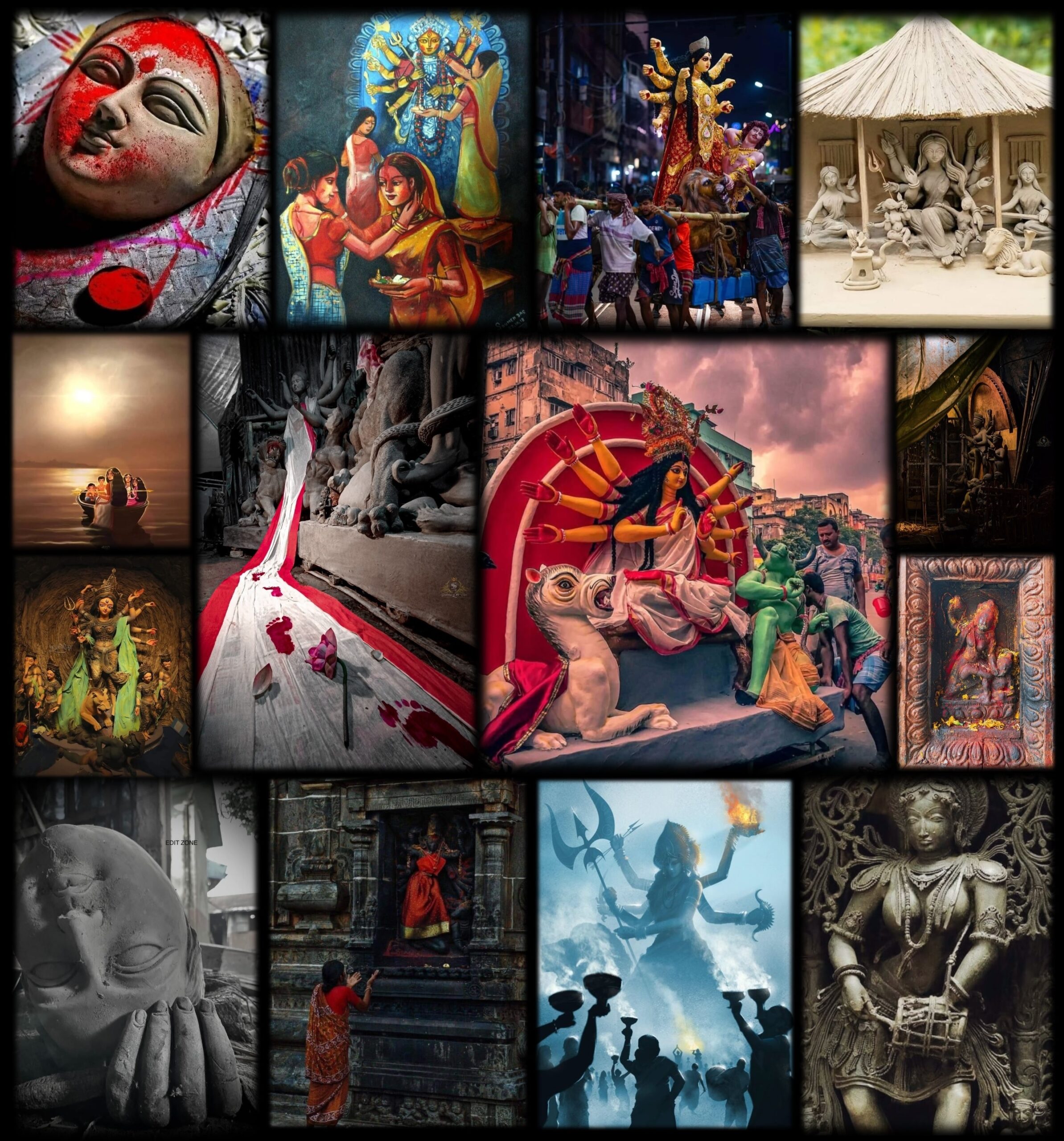- Visitor:16
- Published on:
Invoking Mother Goddess this Navaratri (Part 2)
The appeal of the Mother Goddess had gained an additional dimension in the days of the national struggle for freedom when patriot-poets like Bankim and Bharati saw in Mother India the same Goddess of Sakti and sang the new mantras of ‘Vande Mataram’ and ‘Om Sakti om’. May this triple Goddess bless this country that she might grow into Power, Plenty and Wisdom!

… continued from the last part.
According to this school, the one Supreme Being, Siva, is of the form of Light (Prakāśa); when he becomes creative and is in this dynamic aspect he is called Vimarsa. This latter is called his Sakti and the two represent the twin (yamala) form of the Lord.
This school identifies the Sakti principle with the transcendental speech, Para-Vāk Vimarsa is Sabda or word; Prakāśa is Artha or meaning. Thus, the whole world of thought and expression is essentially of the form of Siva and Sakti, a tenet which Kalidasa also held. It is their devotion to this truth that led many of the leading Kashmirian philosophers to intense cultivation of the literary art, in both its creative and critical phases, as an adoration of the Supreme. Bhaṭṭa Nārāyaṇa says “on any other ground, it would be folly to indulge in verbiage”. Other Säkta schools also subscribe to this doctrine of Devi being an embodiment of the letters of the alphabet (vaṛṇa-mātrikā).
On behalf of the Tantras in general, as far as the world is concerned, the Pariņāma theory is held and it is concluded that the world is not a mere illusion. The Tantras are numerous and do not represent a homogenous system of thought; and the Parinama-vada is after all, as the Advaitins say, only the prelude (purva-bhūmi) of Vivartavāda. The chief contribution of Tantras is on the historical and cultural side. In and around the country, numberless female deities were in vogue among the folk, with primitive modes of worship. These the Tantras took, and submitted to a process of assimilation and adjustment in the general framework of the main current of Indian philosophical and religious thought. The varying degrees of refinement seen in the vast mass of Tantrik literature shows this process of assimilation (a historical parināma, if we may say so), and gradual refinement.
The survivals here of primitive practices have been given an esoteric significance; Abhinavagupta says in one place that Bhairava drinking wine in a skull-cup means really the realized soul having the delectation of the ambrosia flowing from the thousand-petalled lotus in his head. Such worshippers as are not accustomed to non-vegetarian diet are prohibited by texts from using meat in worship. (Durgopasanakalpadruma, p. 201). Just as in devotion, the simile of clandestine love has been mistaken and condemnable practices are indulged in, so also the metaphor of Siva-Sakti union has been abused. Abhinavagupta elucidates (Paratrimśika-vivarana, pp. 183- 84) how by reason of its productivity and the triangular form comprising cogniser, cognition and cognized, the Vimarśa Sakti is called figuratively yoni. In the same manner are to be understood some of the elements of the mythological ramification of the Devi cult in the Puranas. For instance, as Sakti is the Power that makes everything, Śiva is considered by an overemphasis, as being really impotent, and by a further stretch, Devi is made to sit on a seat of five corpses representing the bodies of the five main Gods. For a truer perception, however, it is necessary to get at the underlying ideas of the myths and stories. Thus, taking the story of Devi killing the demon Mahişa etc., we have clues to understand the higher meaning; Rşi Sumedhas, figuring here as the teacher, echoes a line in the Vak-hymn of the Ṛgveda, and stands for spiritual enlightenment; the king’s name Suratha signifies the embodied soul, the body being well-understood as the chariot (ratha), the merchant Samadhi represents concentration. Commentators explain that Chandi signifies terrible immensity and greatness and the demons Chanda and Munda whom she destroys stand for the two forms of nescience, Tülävidya and Mulavidya, and as such Devi really means the knowledge of Self.
Among religious sectarians, who swear by exclusive allegiance to Siva or Visņu, Devi would form an assuaging common ground, a bridge between the two, being described as the sister of the latter and spouse of the former. In the Mahabharata on the eve of the battle, Kṛṣṇa asks Arjuna to pray to Durga; in the Bhagavata, Vişņu asks Yogamāyā to go in advance to help his incarnation, and the cowherd lasses observe a vow in her honour in Märgasirṣa month to obtain Kṛṣṇa as their Lord. The Puranas that have substantial Dev material invariably connect Devi with the story of Rama and say that it was a Navami or ninth of the fortnight that Rama, thanks to Devi’s grace, killed Ravana. The Kälikä (upa) Purana which deals extensively with Devi worship mentions this story as one of the explanations of the widespread worship of Devi in autumn, the Sarada-Navaratra. Devi, it si said, here, is called Sarada because the gods woke her in on Rama’s behalf and for the destruction of Ravana in the Sarat season; but, according to Valmiki’s original, it was already spring when Hanuman visited Lanka, and to adjust this chronological discrepancy, later Purana text called Mahābhāgavati gives a new table-table of Rama’s activities. The Devibhāgavata is more acceptable on this point as, according to it, (III.27.9.52), Rāma observed the Sarada-Navaratra in Kiskindhã on the advice of Narada who tells Rama that those in difficulties should especially observe this worship. However, the association of Rama’s victory Ravana with the Durga-Puja has become so established among people in North India, that the display of Rama-līlā takes place at this time.
The Kalika Upapuraṇa adds that it was during this same Navaratra that Devi killed Mahiṣāsura. According to the Devibhāgavata, (III.26-27), the Navaratra seasons sacred to Devi were really two, one in spring (vasanta) and another in autumn (sarat). The eighth day (Aştami) is of special significance, according to this Purana, as Bhadrakali is said to have manifested herself on that day. The Navaratra is to be observed with fasting, as far as possible, worship, oblations, recitals of Devi-texts, and above all, by the adoration of maidens (Kanya-pujā).
The same Goddess represents all the three forms Mahākāli, Mahalakṣmi and Mahāsarasvati, to all of whom the Navaratra is sacred. Durvāsas says in his Lalitãstavaratna that, when she is contemplated in her saffrom form, she is Kameśvari; when one adores her in her all-white form (as Sarasvati), poetry flows from one; adored as the golden-dued Goddess (Lakṣmi), She makes one the lord of wealth. Not only are the nine days of the Navaratra apportioned to these three forms of the Goddess, but the very text of the Devimahatmya, according to the Santisara and the Rudrayamala, embodies these as the presiding deities of the three stories; Mahäkäli over the killing of demons Madhu and Kaitabha, Mahalakṣmi over that of Mahişăsura and Mahāsarasvati over that if Sumbha and Nisumbha.
The literature of Durga-puja and its several forms and details is a big and bewildering mass. But it is desirable to bear in mind what the Devibhāgavata says before entering into the ramifications of the rituals of this Pūjā. It divides (VII.39) the worship of Devi into the external and the internal, the external into the Vedic and the Tantrik, and the Vedic into the worship of the Cosmic form and the limited form (Para and Murti) among the limited forms, the adoration of these in the Sun, the Moon, the Yantra, or the heart comes first and then only images. Images of Mahiṣāmardani made of earth are to be set up for worship in this season following the practice of Suratha and Samadhi of the Devimahatmya, an extension of this is perhaps the South Indian Kolu or the display of earthen dolls of divinities during the Navaratra. Each preceding form of worship is superior to the succeeding one. The internal worship, which is the highest, is the absorption into Consciousness, which is Her highest form (Samvil-laya) (VII.39.44).
Of Devi-literature, the Devibhāgavata comes first in importance. Its treatment is by far the best. Sāktas have written pamphlets to claim for it the status of a main Purāṇa, as against the Srimad Bhagavata, Next comes the Märkandeya with its Devīmāhātmya or Durgāśaptasati or Chandi, and the Brahmaṇḍapuraṇa carrying Lalitopakhyana and the hymn of the thousand names of Goddess Lalita; these two, the Devimahātmya and the Lalita sahasranamastotra are the two main sacred texts of the Devi-worshippers. Among Upa- puranas, we have the older Kälikä, and the later ones called Satipuraṇa and Mahābhāgavata. The hymnal literature on Devi is partly canonical, e.g., Durvasas’s Saktimahimnasstava and Lalitãstavaratna, the Devipañcastavi and Sankara’s Soundaryalahari. Of poetic and devotional outpourings, the Mūkapañcasati on Kamakṣi is the most remarkable hymn.
Once the Indian Durga worship had spread as far as Cambodia. In ancient India, coinciding with the end of the rainy season and the beginning of the season for military campaigns, the autumnal Navaratra had a national significance to the Kings and the people. Symbolising the worship of the triple Goddess of Power, Plenty and Wisdom, the Navaratra holds in modern times tremendous possibilities as the foremost national festival. The appeal of the Mother Goddess had gained an additional dimension in the days of the national struggle for freedom when patriot-poets like Bankim and Bharati saw in Mother India the same Goddess of Sakti and sang the new mantras of ‘Vande Mataram’ and ‘Om Sakti om’. May this triple Goddess bless this country that she might grow into Power, Plenty and Wisdom!
Bibliography:
Taken from the Chapter titled “Mother Worship” from “Facets of the Vedas” by Dr. V. Raghavan
Center for Indic Studies is now on Telegram. For regular updates on Indic Varta, Indic Talks and Indic Courses at CIS, please subscribe to our telegram channel !
- 8 min read
- 0
- 0










